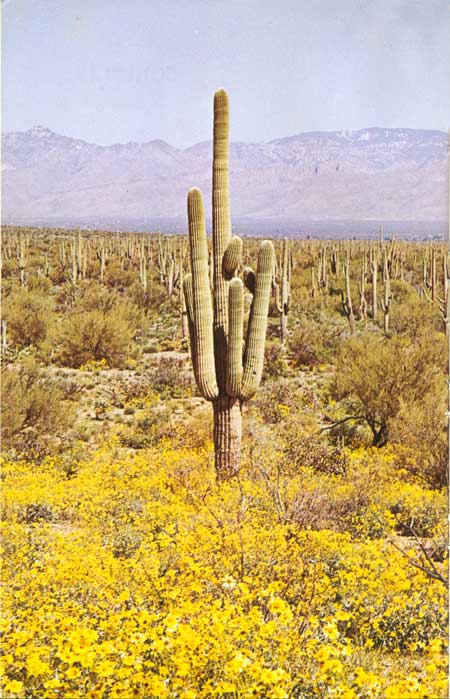|
SAGUARO National Park |
 |
the desert scene
Scattered through the wide, lonely Sonoran Desert, isolated mountain ranges raise jagged blue silhouettes against the sky. The high ones wear a crown of dark pines and a speckled mantle of oaks. Lapping against their feet is the desert sea, studded with the green masts of giant saguaro cactuses rising above a motley crew of tough, strange, often handsome subordinates.
On either side of the Santa Cruz Valley in southeastern Arizona, Saguaro National Monument embraces two of these ranges, with the desert lands at their feet. Although it was established primarily to preserve impressive stands of saguaros, it gains wholeness by including the mountains that shed the rocky soil on which the saguaros grow. The monument is in two sections, some 30 miles apart. The Rincon Mountain Section, east of Tucson, includes in its 99 square miles a spectrum of plantlife ranging from saguaro communities at the low elevations to a wet fir forest on the north slope of 8,666-foot Mica Mountain. The 24-square-mile Tucson Mountain Section, about 12 miles west of the city, has a denser stand of saguaros, on the lower slopes of a wild jumble of volcanic mountains dominated by 4,687-foot Wasson Peak.
Within the cactus forests and upon the mountain slopes, life in myriad forms goes on in a delicate and continuous adjustment to changing environments. Over millennia, mountains rise and crumble, species evolve and fade from the scene. Over days and weeks and years, populations of plants and animals rise and fall, in response to thousands of interactions which we are only beginning to understand. In the following pages, we will meet the main characters in this natural drama (including some of the most improbable in all of nature); we will investigate the environmental stage upon which they perform; and we will try to understand something of the play itself, including our own role in it.
 Brittlebush display along Cactus Forest Drive. (Photo by Harold T. Coss, Jr.) |

|

|
| NPS History | History & Culture | National Park Service | Contact |
|
Last Modified: Sat, Nov 4 2006 10:00:00 pm PST |


